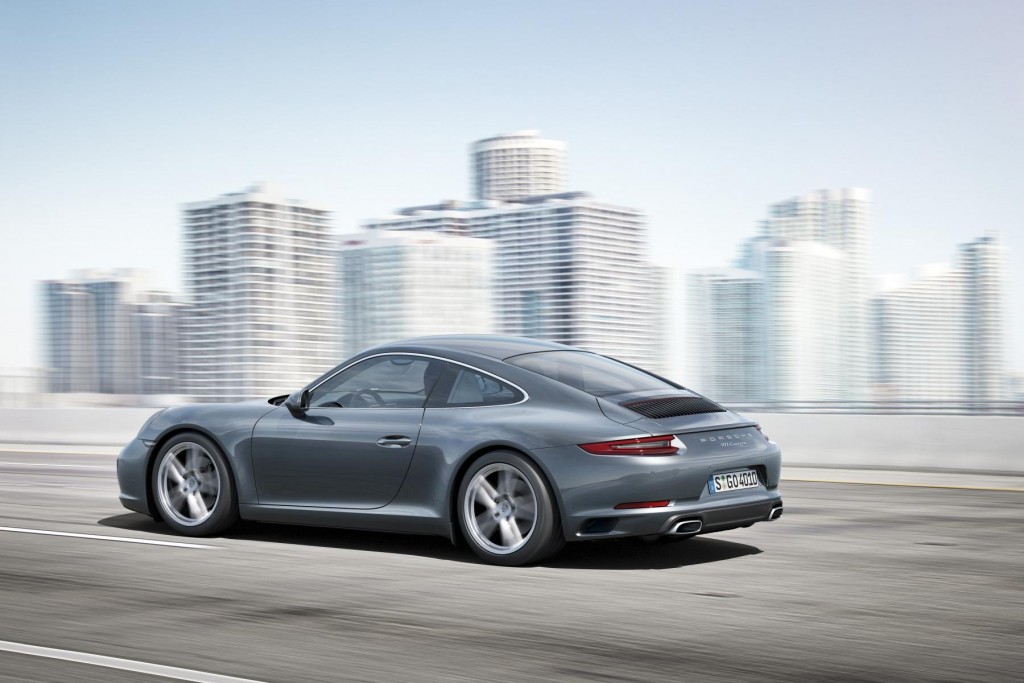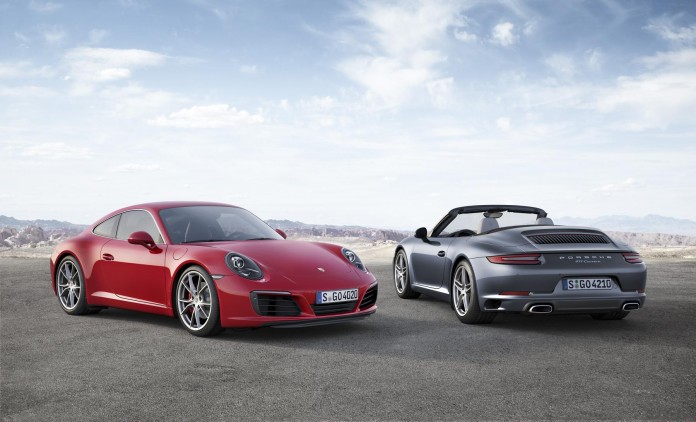The 991-generation 911 is getting a nice mid-cycle refresh for 2016, and the biggest news is the addition of an entire new family of engines. Starting next year, every 911 from the base Carrera up to the Turbo S will have turbochargers.
Yeah, I think it will be confusing as well.
The base Carrera’s motor is still a 3.0-liter flat-six, but it has been redesigned and thanks to the addition of two small turbos, power has been boosted by 20 hp to 370. The Carrera S will use the same 3.0-liter motor, but thanks to adjustments in the turbos, boost and tuning, it will produce 420 horsepower. Of course more power is always welcome, but the big reason for the swap is increased fuel economy. Buyers of the new car can see as much as a 12-percent gain on the MPG rating.
Other changes for the new 911 include an updated PCM infotainment system with navigation on all models, wider rear tires on all cars, standard PASM chassis system and tuning, and a small collection of visual alterations.
To set the new 991.5 apart from the old cars, there are new headlights, door handles, taillights and rear decklid with new grille pattern.
If you want even more details about the new car, just check out Porsche’s full press release below. We expect a full gallery of photos when the car is officially unveiled next week at the Frankfurt Auto Show.

PRESS RELEASE
Atlanta, Georgia. Celebrating its debut at the Frankfurt International Auto Show, the new 911 Carrera is taking performance and everyday usability to new heights. Innovative flat-six engines derived from four decades of turbocharging used in racing and on road cars not only make this the fastest 911 Carrera ever, but also provide abundant torque for superior passing power. An advanced chassis offering an even more sophisticated combination of ride comfort and performance characterizes the handling of the new 911. For the first time, rear-axle steering is available as an option for the Carrera S, significantly enhancing its already superb agility. These improvements reduce the lap time on the North Loop of the Nürburgring to just 7 minutes and 30 seconds, making it 10 seconds faster than the previous Carrera S.
Many exterior features of the 911 Carrera have been visually refined from new headlights with four-point daytime running lights to integrated door handle recesses, a redesigned rear deck lid with vertical louvers, and new rear lights – including the characteristic four-point brake lights. The new standard Porsche Communication Management system with a multi-touch display offers an expanded range of functions and simplified usability.
New turbocharged engines: 20 horsepower increase, reduced fuel consumption
The completely new engine generation featuring twin-turbo technology enhances the driving pleasure of the 911 Carrera and provides a 20 hp increase compared to the previous models. The 3.0 liter engine in the standard Carrera now develops 370 hp. Using turbochargers with modified compressor wheels, a model-specific exhaust system, and a different tune for the engine management system, the 911 Carrera S delivers 420 hp from the same displacement. The new Porsche 911 Carrera and Carrera S engines are characterized by significantly increased torque. Offering up to 331 lb.-ft. and 368 lb.-ft., respectively, from 1,700 rpm up to 5,000 rpm, both powertrains supply generous torque over a broad powerband. Reaching up to 7,500 rpm, the new engine generation also maintains relatively high engine speeds for a turbocharged powertrain – accompanied by the familiar Porsche sound.
Traditionally, a new 911 offers enhanced performance and efficiency compared to the predecessor. Depending on the model variant, the new engines are almost twelve percent more efficient compared to the previous generation according to the New European Drive Cycle (NEDC). EPA ratings will be available at a later date.
The new 911 models also boast impressive performance: the 911 Carrera Coupé with Porsche-Doppelkupplung (PDK) and Sport Chrono Package sprints from zero to 60 miles per hour in 4.0 seconds – making it two tenths of a second faster than its predecessor. The 911 Carrera S with PDK and Sport Chrono Package needs just 3.7 seconds (also 0.2 s faster). Both models reach higher top track speeds: the 911 Carrera is now able to reach 183 miles per hour, while the 911 Carrera S can achieve up to 191 miles per hour. All new Carrera variants are offered with a manual seven-speed transmission as standard.
When equipped with the optional Sport Chrono Package, the 911 Carrera now comes with a mode switch on the steering wheel, derived from the hybrid map switch in the 918 Spyder. The mode switch consists of a rotary dial with four positions for the driving modes Normal, Sport, Sport Plus, and Individual. Depending on the optional equipment installed in the car, the Individual setting allows drivers to configure their own specific vehicle set-up for the chassis, Auto Start/Stop system, PDK shifting strategy, and Sport Exhaust System. On models equipped with the PDK transmission, the mode switch has a “Sport Response” button, which pre-conditions the drivetrain for maximum acceleration.
A standard feature: reengineered PASM with chassis lowered by ten millimeters
The uniqueness of the 911 Carrera stems from its ability to blend refined everyday comfort with exceptional performance. On the new generation, Porsche has increased the dynamic capability even further than before. The revised PASM chassis (Porsche Active Suspension Management), which lowers the ride height by ten millimeters, is a standard feature. It helps improve driver control during fast cornering. New shock absorbers enhance comfort thanks to an even more precise response characteristic and improved body control during spirited driving. New standard wheels with five twin spokes are equipped with tires that offer reduced rolling resistance and enhanced grip. Furthermore, the width of the rear rims has been increased by 0.5 to 11.5 inches on all variants. The rear tires of the 911 Carrera S now measure 305 instead of 295 millimeters in width.
Rear-axle steering is available as an option for the 911 Carrera S, adopted from the current 911 Turbo and 911 GT3. It further enhances the turn-in behavior of the 911. Additionally, it increases driving precision when changing lanes at higher speeds. At the same time, it ensures greater maneuverability in city traffic thanks to a turning radius that is 1.6 feet smaller than without this option. The improved handling is transmitted to the driver via the new steering wheel generation with a design based on the steering wheel from the 918 Spyder. For enhanced everyday practicality, Porsche offers an optional electro-hydraulic lift system with lifting cylinders that are integrated into the front axle struts. At the touch of a button, the ground clearance at the front axle is increased by 40 millimeters within 5 seconds. This is particularly useful when clearing speed bumps or steep driveways.
New Porsche Communication Management including online navigation
A standard feature of the new 911 Carrera models is the newly developed Porsche Communication Management System (PCM), including an online navigation module. The PCM can be operated by multi-touch gestures on the seven-inch display, similar to a smartphone. Handwritten user inputs are recognized. Mobile phones and smartphones can now also be connected via Wi-Fi. Also new is the option of connecting an iPhone® to the PCM to utilize Apple CarPlay™.
Real-time traffic information is available for significantly enhanced navigation. It gives the driver a quick overview of the traffic situation and guarantees dynamic adaptation of the route to this information. Google® Earth and Google® Streetview are also being integrated for the first time to offer better orientation. Porsche Car Connect and the Connect Plus module can be used for remotely controlled vehicle functions, transferring destinations to the PCM for navigation and streaming music using third-party service providers via the PCM.
Market launch in March 2016
The new Porsche 911 Carrera models will be launched in the United States in March of 2016. Manufacturer’s suggested retail prices start as follows:

40 years’ turbo experience in motorsport and series production
At Porsche, innovations and developments that have proved themselves under extreme racing conditions benefit production models, too. Testing in motorsport ensures the performance and resilience of the new engines for production sports cars. In the development of turbocharged six-cylinder flat engines Porsche can look back on more than 40 years of experience. For example, turbocharging with a bypass valve was first used in 1972 in the 917/10 racing car before entering series production in 1974 in the first 911 Turbo. In 1974, charge air cooling was also first introduced in the 917/10. In 1977, this technology then celebrated its premiere in the 911 Turbo 3.3. Further milestones in the development of turbo engines include sequential turbocharging with two consecutive chargers (for the first time in the 959), twin-turbo charging with two parallel chargers (for the first time in the 911 Turbo, type 993) and adjustable intake valves (for the first time in the 911 Turbo, type 996).


